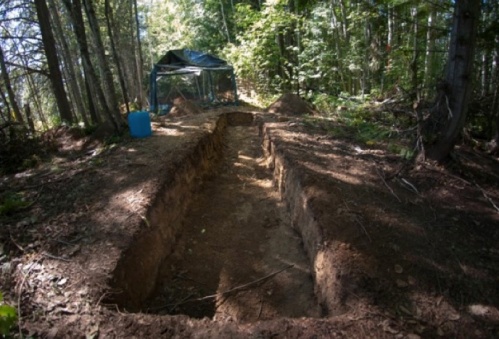
Unusual serrated stone tool from Gitwangak area site, perhaps used for cedar processing. Source: CBC
There’s a nice audio interview and slide show from the CBC with Jenny Lewis of Kleanza Consulting archaeologists about a dig going on along the Skeena River near Gitwangak (Kitwanga) in Gitxan Territory. The project is apparently a CN Rail siding repair and there have been many, many stone tools found, including some in stratified setting with carbon dates associated.
Remarkably, Lewis asserts that they have material dating to around 9,000 years ago, in addition to the more recent finds. This would certainly make it amongst the oldest, if not the oldest, archaeological material known from the Skeena River area, although it is not specified how the earliest date estimates were arrived at. The well-known sites in the Kitselas Canyon, for example, are generally all within the last 5,000 years if memory serves me right.
Lewis also does a nice job of contextualizing the dig in relation to the present day interests and outlook of the Gitxsan, and the CBC’s Betsy Trumpener does a good job of interviewing her. It’s one of the better archaeology in the media experiences of late – I suppose there may well be underlying tensions about the development project itself and these are not raised, but overall I enjoyed the interview and would like to know more. The only flaw is that the CBC’s slideshow does not have captions, or, to be precise, it has empty captions.
Anyway, if anyone knows exactly how the 9000 year old estimate is reached, post in the comments! I got the impression the early date was not from radiocarbon dating, so perhaps stylistic characteristics of artifacts?




Hey Quentin,
Interesting post. This was probably my favourite part of the province I have visited so far.
I hope you and your family are doing well.
LikeLike
I believe Morley found a point very similar to the one found here near Prince Rupert a few years back. He thought it was in the 9,000 time frame too – Cue Morley:
LikeLike
WRT to the unusual serrated stone at the top of the page, while I am not familiar with the context of its recovery or even the culture history of your region, if we found that artifact in the northeast (of North America), I’d suggest it was used to decorate ceramic pots (rocker dentate).
LikeLike
Hi Jason. Thanks for your comment. There is essentially no evidence for ceramics on the NW Coast – if memory serves there are some small fired clay figures / faces from the lower Columbia River. Of course, far to the north in the Bering Straits there was also a ceramic tradition in Norton Culture. But no tradition of pottery per se on the NW Coast — and I think we’d know if there was because it preserves well and tends to be ubiquitous where present.
LikeLike
Hi all,
Thanks for the positive coverage Quentin — it was a great project to work on, and we’re always excited to get people (consultants, academics, and the public) talking about archaeology.
I should clarify: I didn’t “assert” that the site is 9,000 years old. We do have paleo-sediments which date to immediately post-glaciation in the Skeena corridor, and we have stylistically-early projectile points above them. While we do believe that these artifacts have potential to be that old, analysis is still being done. The only “conclusive” dates we have are carbon dates from later strata, which were dated at approximately 2,300 BP.
A draft final report has been completed and will be available via the online report registry once it has been finalized and reviewed. As we believe this site to be significant for the region, I will also be pulling together a publication which will address issues of dating and settlement in the region, with regards to the site we excavated specifically.
We’ve received a lot of positive feedback from our work on the site this summer from the immediate community and our colleagues — it’s been great. Hopefully the discussion continues between all stakeholders in BC archaeology.
Jenny
LikeLike
Hi Jenny. Thanks for your comment. I’m sorry if I misrepresented your comments in the interview. It struck me you were fairly confident in the early Holocene age assignment though clearly you did not say there were radiocarbon dates that supported the stylistically-early artifacts. It’s an exciting find regardless – the Skeena is surprisingly poorly known other than Kitselas area, wouldn’t you say?. Look forward to hearing more — maybe at NWAC or the CAAs?
LikeLike
Hi Quentin — I couldn’t agree more that we need more information and understanding of the Skeena region. Despite dates, we truly believe this site (and this project) to be significant and look forward to being able to share more information about it as we undertake our analyses.
So far there’s no presentation planned for NWAC or the CAAs, but there may be a brief recap at the BCAPA AGM on March 2. We’re also putting together a presentation for the SAAs in Honolulu.
Very exciting all around!
LikeLike
http://www.nwcc.bc.ca/Programs/Academic/Overview.cfm?Program=BVFS there a photo of another serrated stone from a site fairly close, this is outside Smithers Bc, in moricetown canyon.
Segmented groundstone artifact from Moricetown Canyon
LikeLike
Hi Cody — belated thanks for that, it is indeed very similar indeed.
Jenny – I plan on being at the SAAs so will try to catch your paper or poster…
LikeLike